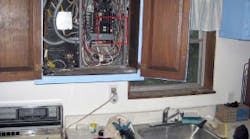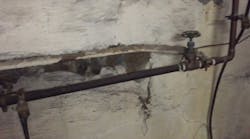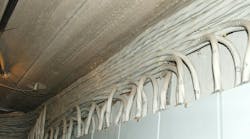What's for Dinner?
This beautiful installation was sent to us by John Anderson, a longtime reader, who thought EC&M readers would find this a useful exercise in identifying Code violations. Boy, oh boy, he couldn't have given us a more interesting challenge.
The most obvious violation with this ridiculous installation is the lack of “Work Space,” as defined by 110.26. Part (A)(1) defines the “depth” of work space. While the minimum “depth” required by Table 110.26(A)(1) of 3 ft is satisfied with the cabinet doors open, it could be argued that closing the cabinet doors essentially constitutes a violation of the rule in the first paragraph of 110.26, which states, “Sufficient access and working space shall be provided and maintained about all electrical equipment to permit ready and safe operation and maintenance of such equipment.”
And while it appears that the minimum 30 in., or the equipment width, as specified in 110.26(A)(2), has been provided, it seems as if a person would be put in a compromised position while working on this panel, because reaching inside the cabinet would limit the “elbow room” this rule is intended to ensure. Again, although this is a rather rigid interpretation, remember that the rules in 110.26 are among the very few Code rules that are intended to provide protection for electrical maintenance and operations personnel. Virtually all other Code requirements are intended to provide protection for the general public. That's not to say we should care more about protecting electrical professionals, but we certainly shouldn't care less about ensuring they have a safe working environment.
The one undeniable violation here is the failure to comply with 110.26(A)(3). This section says, “The work space shall be clear and extend from the grade, floor, or platform to the height required by 110.26(E). Within the height requirements of this section, other equipment that is associated with the electrical installation and is located above or below the electrical equipment shall be permitted to extend not more than 150 mm (6 in.) beyond the front of the electrical equipment.”
Obviously, the cabinet in which the panel is located is not part of the “electrical installation.” Therefore, the cabinet is intruding on the required work space “height.” The countertop is also in the work space. Furthermore, the electric range, which technically is part of the “electrical installation,” is not the kind of equipment that is addressed by the wording of 110.26(A)(3). Even if it was, it clearly extends beyond the 6-in. maximum stipulated by this rule.
Another concern is the white-colored conductor terminated under a circuit breaker terminal. It is not completely clear exactly what the white conductor is being used for, but whether this is a phase or neutral conductor, such use is either a violation of 200.6(A) or 240.22. The first sentence in 200.6(A) states, “An insulated grounded conductor of 6 AWG or smaller shall be identified by a continuous white or gray outer finish or by three continuous white stripes on other than green insulation along its entire length.” If the conductor in question is a phase conductor, then it may not be colored white, which is reserved for grounded conductors only.
If the conductor in question is, in fact, a grounded conductor, then this application violates the rule of 240.22, which says, “No overcurrent device shall be connected in series with any conductor that is intentionally grounded, unless one of the following two conditions is met: (1) The overcurrent device opens all conductors of the circuit, including the grounded conductor, and is designed so that no one pole can operate independently,” or “(2) Where required by 430.36 and 430.37 for motor overload protection.” Neither one of those conditions exists here; therefore, if this is a grounded (neutral) conductor, it's a violation of 240.22.
An Energy-Efficient Installation in the Shower?
This photo was sent to us by Walter P. Garner, P.E., principal engineer, Engineering Dept., The Birmingham Water Works Board, Birmingham, Ala. Garner wasn't sure where this picture was taken, but it was sent to him by a friend. (Hopefully, this isn't a photo of his friend's shower!)
This clearly appears to be an outdoor lighting fixture with an integral occupancy sensor. If that's the case, then the rule of 410.10(A), “Wet and Damp Locations” has been satisfied. If this fixture is not listed for use outdoors, then the likelihood it's listed for “wet” or “damp” locations is not very high — meaning this would be a clear Code violation.
As all of you should know by now, fixtures installed in the bathtub and shower area must be listed for either damp or wet locations, depending on whether the fixture is subjected to the direct spray of the shower head or not. In other words, if the fixture is subject to the direct spray of the shower head, then it must be listed for use in wet locations; if not, then it must be listed for use in damp locations.
While the fixture in question may, or may not, be listed for wet and damp locations, you have to wonder why there is a need for an occupancy sensor-controlled lighting fixture in a shower stall. Maybe this is how the homeowner chips away on the energy-savings front. Hopefully, he's intelligent enough not to try and change the bulbs while the shower is running.






